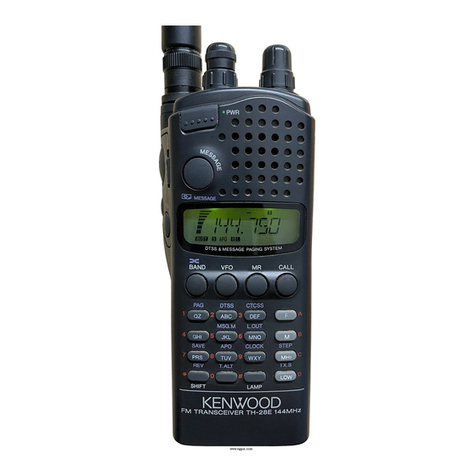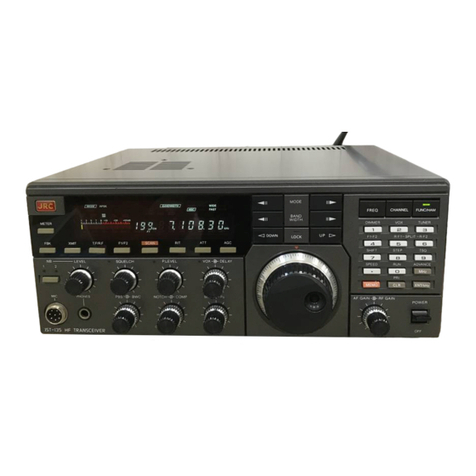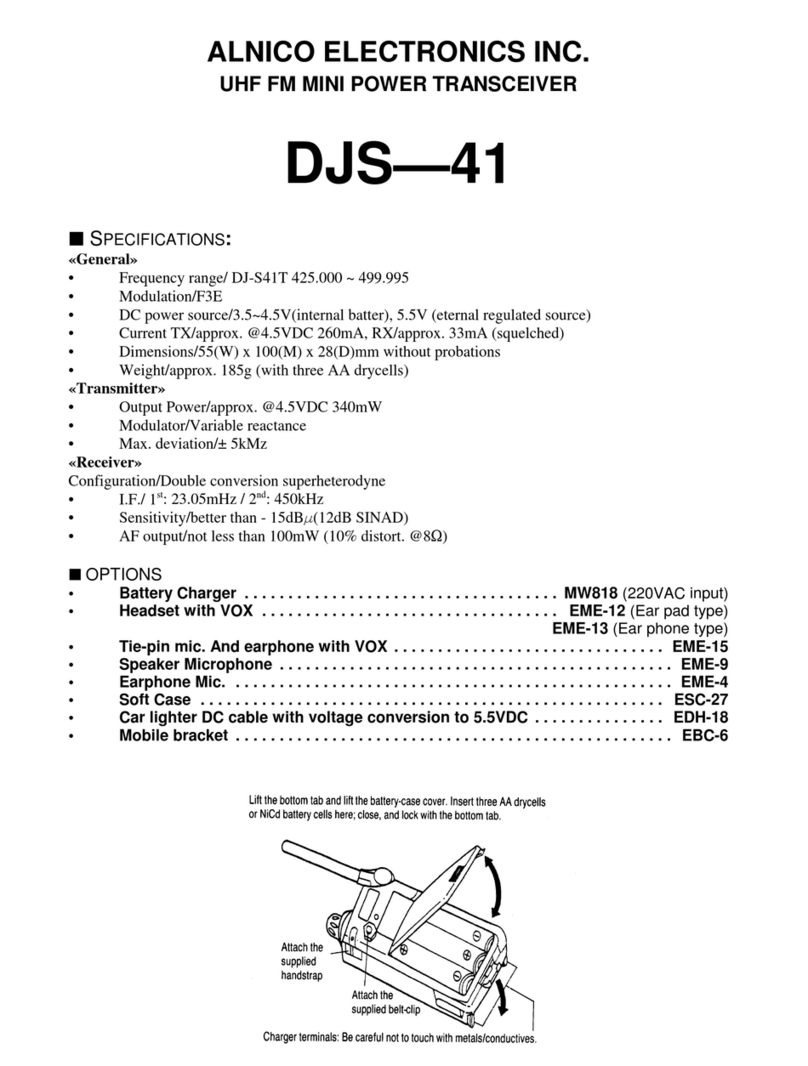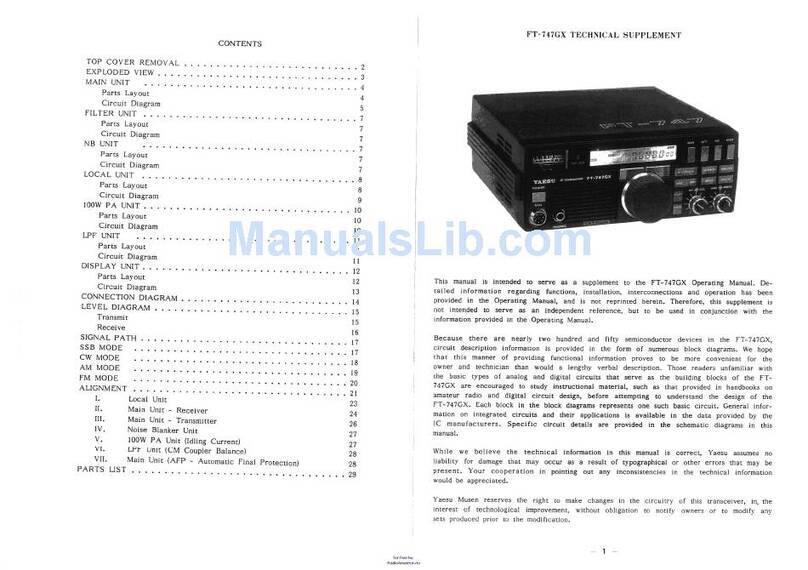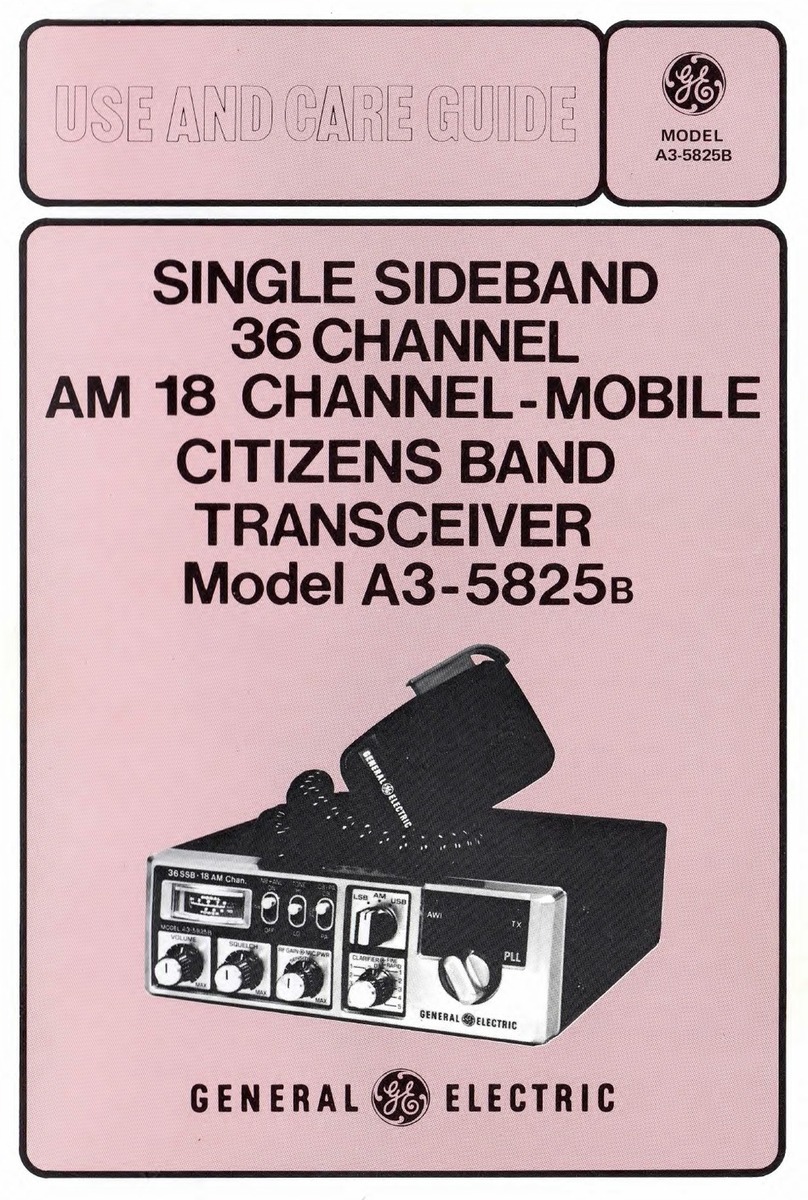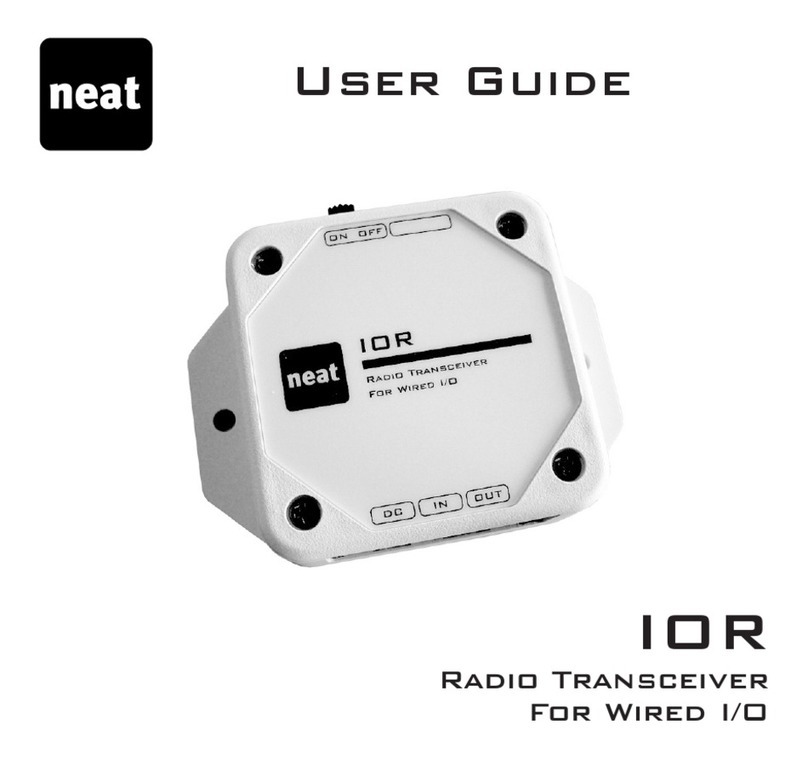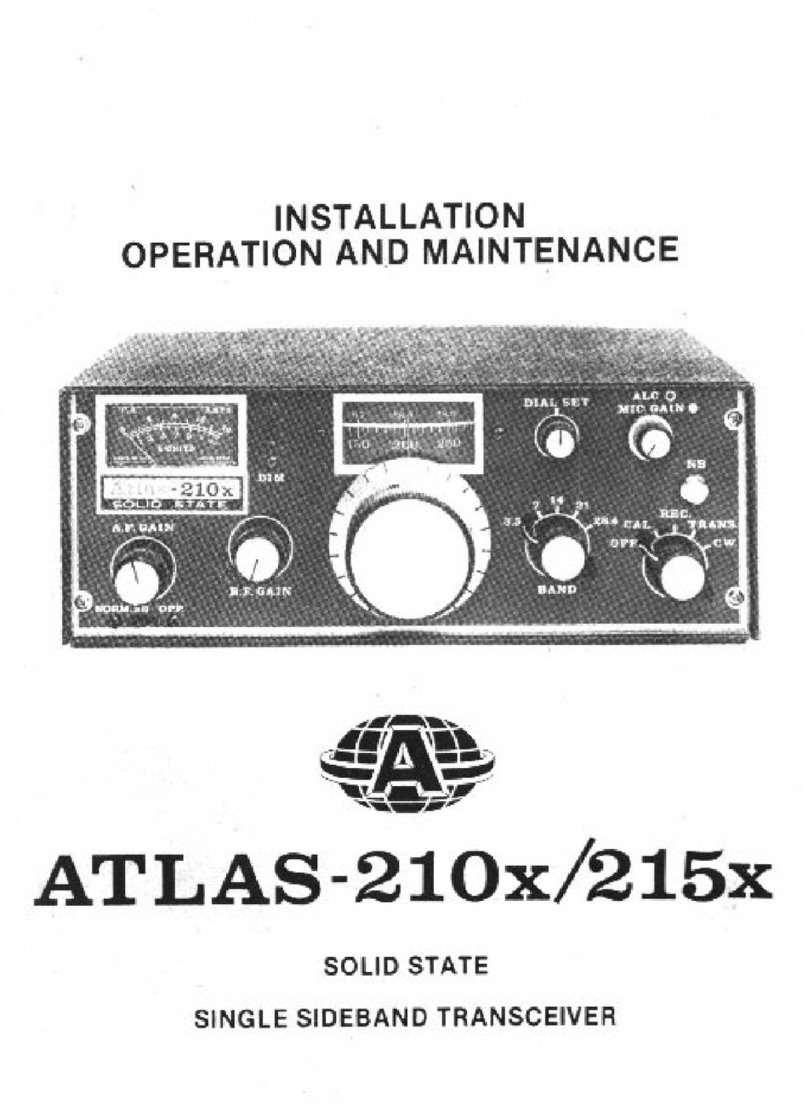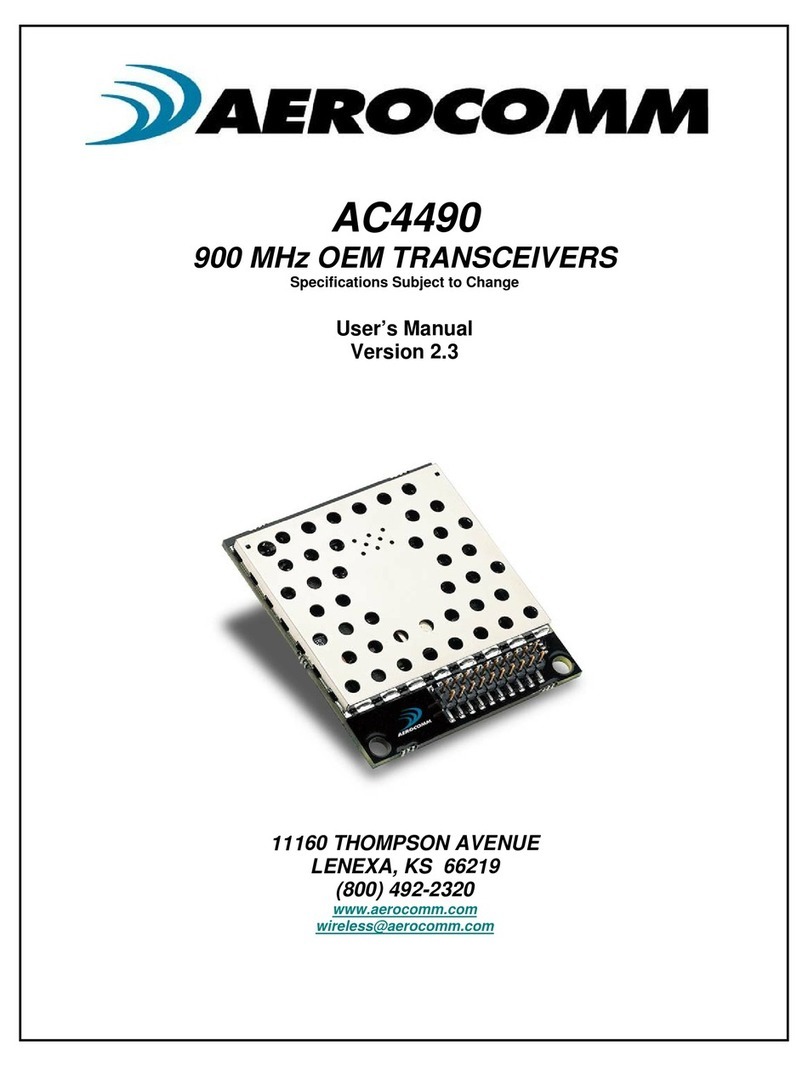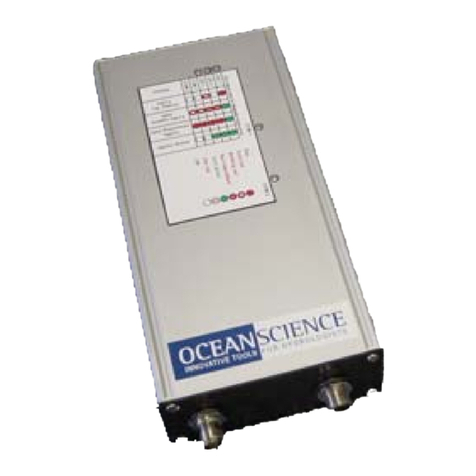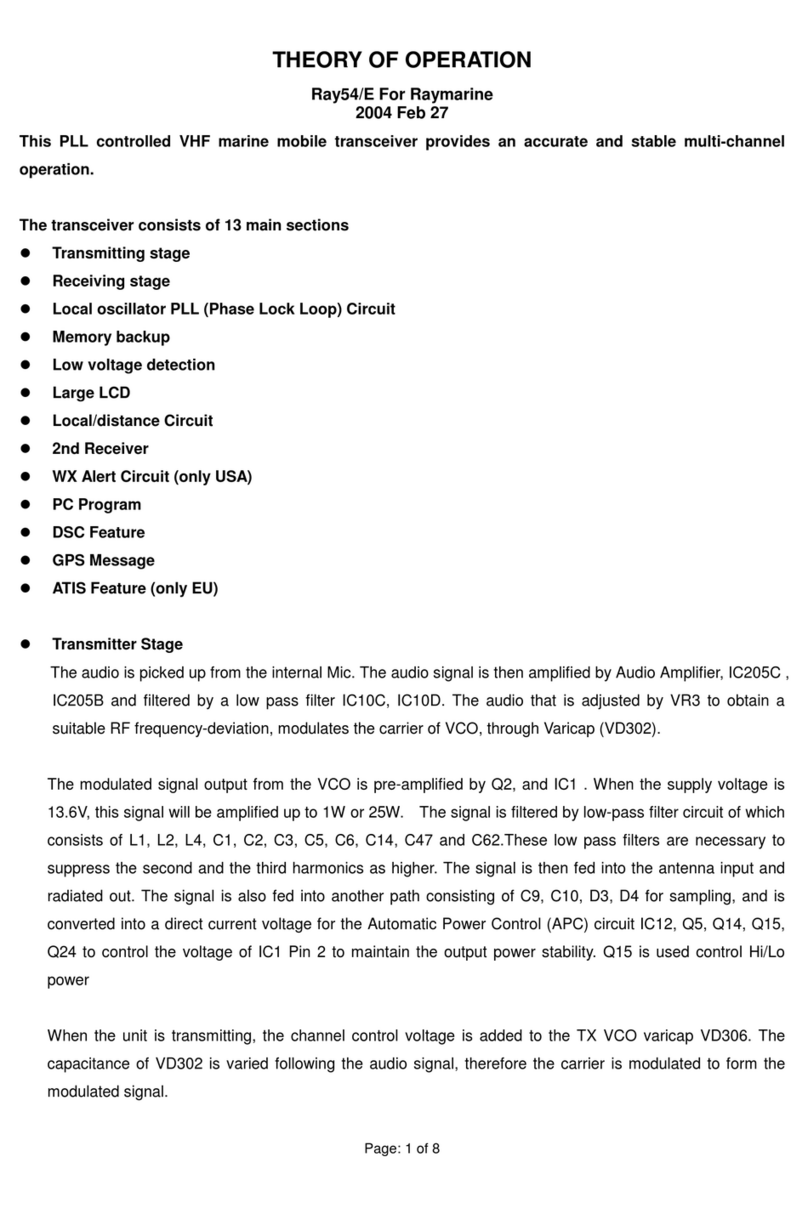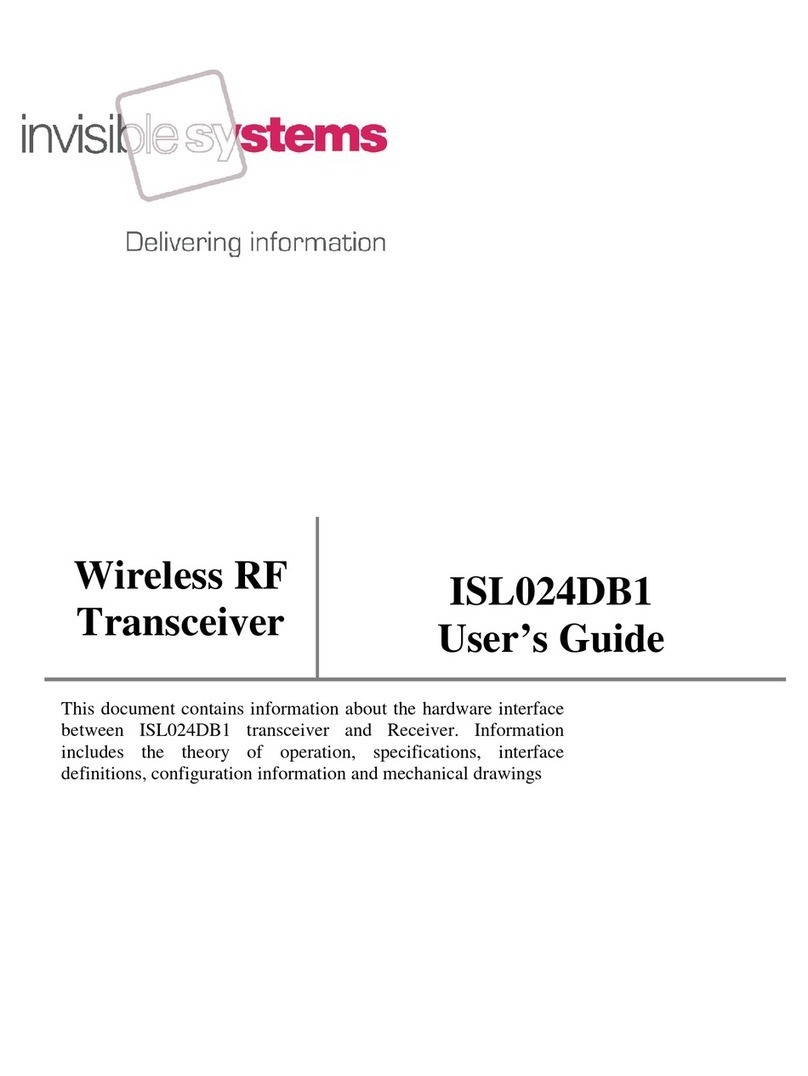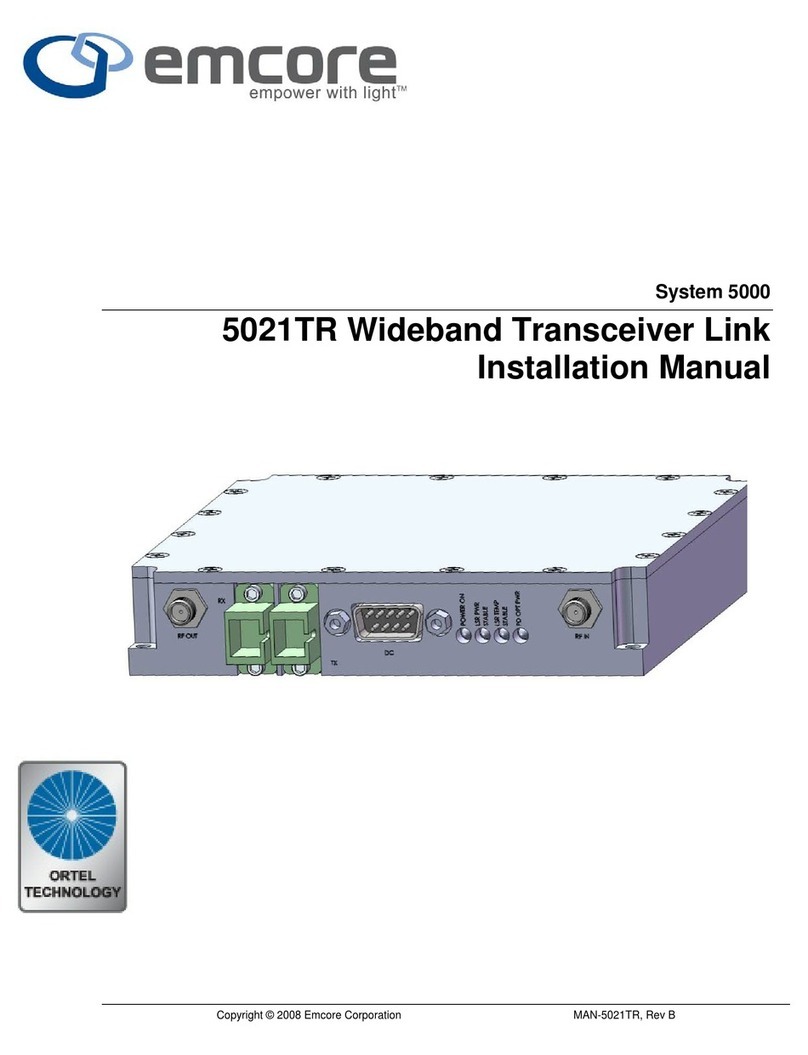AALogic TriTone User manual

Allied Analogic, Inc.
TRITONE TRANSCEIVER
User Guide Version 2.2

Allied Analogic, Inc. 1Copyright © 2019
TABLE OF CONTENTS
1Overview: Tone Sender, Receiver, Meter, and TDR............................................. 3
2Connections ............................................................................................................. 3
3Operation ................................................................................................................. 4
3.1 Power............................................................................................................. 4
3.2 Battery Level ................................................................................................. 4
3.3 Configuration - System................................................................................ 4
3.3.1 Backlight................................................................................................... 4
3.3.2 Contrast.................................................................................................... 5
3.3.3 Volume ..................................................................................................... 5
4Sending Tone ........................................................................................................... 5
4.1 Frequency Selection..................................................................................... 5
4.2 Level Selection.............................................................................................. 5
4.3 Tone Mode Selection ................................................................................... 6
4.3.1 Smplx 1T ................................................................................................... 6
4.3.2 Smplx 3T................................................................................................... 7
4.3.3 TRI-PLEX.................................................................................................. 7
4.3.4 Cable Identification................................................................................. 8
5Probe......................................................................................................................... 8
5.1 DAP-125 Probe.............................................................................................. 8
5.2 TONE Function ............................................................................................ 8
5.2.1 Squelch ..................................................................................................... 9
5.3 DSL FREQ Mode .......................................................................................... 9
5.4 DSL SCAN Mode .........................................................................................10
6Meter Functions......................................................................................................10
6.1 Three Terminal Metering ...........................................................................10
6.2 Meter Connections......................................................................................10
6.3 Meter –DC....................................................................................................11
6.4 Meter –Noise (AC) ......................................................................................11
6.5 Time Domain Reflectometer (TDR)...........................................................11

Allied Analogic, Inc. 2Copyright © 2019
6.5.1 Connections ............................................................................................ 12
6.5.2 TDR Measurement ................................................................................. 12
6.5.2.1 Velocity of Propagation (VOP)......................................................... 12
6.5.2.2 Gain..................................................................................................... 13
6.5.2.3 Range .................................................................................................. 13
6.5.2.4 Pulse Width........................................................................................ 13
6.5.2.5 ZOOM................................................................................................. 13
6.5.2.6 TDR Examples....................................................................................14
7Specifications .......................................................................................................... 15
8Warranty .................................................................................................................16

Allied Analogic, Inc. 3Copyright © 2019
1OVERVIEW: TONE SENDER, RECEIVER, METER,
AND TDR
The TriTone Transceiver is designed for identifying cables and cable pairs by
generating identification tone at 577Hz or 987Hz at one of three amplitudes;
Normal, High, and Maximum. The TriTone Transceiver provides Simplex and
Triplex tone modes allowing the user to select the best mode for the application.
The TriTone Transceiver tone is used with existing amplifier probes; filtered,
tunable, or unfiltered. Receivers with aerial coils and hand coils that are
compatible with 577 Hz or 987 Hz can also be used to receive TriTone Transceiver
tone.
The TriTone Transceiver includes automatic visual and audible short/ground
indications to assist in confirming pair identification.
The TriTone Transceiver includes a tone amplifier and internal speaker for
receiving tone sent on cable and pairs. The tone can be from another TriTone
Transceiver or other tone source sending 577Hz or 987Hz tone. The DAP-125
differential amplifier probe is provided for superior tone reception and pair
identification.
The TriTone Transceiver also includes an option to probe for HDSL, T1, or VDSL
signals on pairs to identify pairs with data (Special Circuits). A DSL Scan feature
allows probing for DSL type circuits without specifying a particular mode.
Metering functions built into the TriTone Transceiver allow the user to check DC
and AC voltages (noise) on the pair. This is helpful in identifying the type of
service on the pair or possible defects such as foreign voltage or excessive noise.
Finally, the TriTone Transceiver includes a TDR. This is helpful when selecting a
vacant pair for assignment. The TDR provides length and fault status.
2CONNECTIONS
The TriTone Transceiver has a Pair Cord, with Red and Black needle clips, DAP-125
Probe, Ground Cord, and charger. Connect the Pair Cord assembly or DAP-125
and the Ground Cord to the jacks located on the top of the TriTone Transceiver.
The ground cord is only needed when sending tone.
The Pair Cord clips and Ground should be connected to the pair and shield of the
cable as needed when sending tone.
Charger
Pair Cord
Or
DAP-125
Ground Cord

Allied Analogic, Inc. 4Copyright © 2019
Pair Identification, SMPLX 1T,
SMPLX 3T, and TRI-PLEX
Black clip to Tip wire, Red clip to Ring wire,
and Ground clip to shield/ground
Pair Identification, Metallic
Green Ground clip to Tip wire and Red Clip
to Ring wire
Meter
Black clip to Tip wire, Red clip to Ring wire,
and Ground clip to shield/ground*
TDR
Black clip to Tip wire and Red clip to Ring
wire
A wire connected to a suitable ground can be connected to the ground binding post
on the TriTone Transceiver in place of the ground cord if needed. This can be used
when the best ground is some distance from the testing point. Using the shortest
ground possible improves meter measurements.
*The Ground clip is not required if T
G or R
G measurements are not needed.
3OPERATION
The following information describes the operation of the controls on the TriTone
Transceiver.
3.1 POWER
The [PWR/CLR] key used to turn the unit on and off.
•Press and hold the key for 1 to 2 seconds to turn the unit on.
•Press and hold the key for approximately 3 seconds to turn the unit off.
•The [PWR/CLR] key is also used to terminate any function and return to
the main menu.
3.2 BATTERY LEVEL
A battery level indicator is displayed in the top, left corner of the display. The
batteries are rechargeable by plugging the supplied charger into the connector on
the top of the unit. When only one bar is shown in the battery level indicator, the
unit should be charged as soon as practical.
The unit may be used while power is supplied to the charge connector if an external
power source is available; however, the power supply should not be used when
using the AC noise meter function.
3.3 CONFIGURATION - SYSTEM
3.3.1 BACKLIGHT
The display backlight can be adjusted for various light conditions. Note that lower
backlight settings will extend the battery duration.

Allied Analogic, Inc. 5Copyright © 2019
•Press [CFG], then [F1] BCKLTE.
•Use the [F2] ▼and [F3]▲keys to adjust the backlight
•Press [F1] Set to save the setting.
3.3.2 CONTRAST
The display contrast can be adjusted as needed. Temperature may affect the
contrast. The contrast may need to be turned down in hot conditions or turned up
in cold conditions.
•Press [CFG], then [F2] CONTRST.
•Use [F2] ▼and [F3]▲keys to adjust the contrast
•Press [F1] Set to save the setting.
3.3.3 VOLUME
The key push beep and probe volumes are adjustable as needed. The probe volume
is adjustable in the probe function.
•Press [CFG], then [F3] VOLUME
•Use [F2] ▼and [F3]▲keys to adjust the KeyPush volume
•Press [F1] Set to save the setting
4SENDING TONE
The TriTone Transceiver provides tone sending options for identification of cables
or cable pairs.
4.1 FREQUENCY SELECTION
The TriTone Transceiver generates 577 Hz or 987 Hz tone. Select a tone that is
compatible with the tone probe(s) that will be used. The TriTone Transceiver
retains the previous selection when the power is turned on. The frequency can be
set from the Main screen or any tone operating screen.
•Press the [FREQ] key
•Use [F2] ▼and [F3] ▲keys to select the desired frequency
•Press [F1] SET.
4.2 LEVEL SELECTION
The TriTone Transceiver offers transmit tone levels at Normal, High, and
Maximum. The lowest level that allows identification of the cable pairs should
normally be used. Higher tone levels may increase inductive coupling to adjacent
pairs and make it more difficult to identify the correct pair.

Allied Analogic, Inc. 6Copyright © 2019
High tone levels can aid in the location of cables. The high levels provide more
signal outside the cable.
The TriTone Transceiver tone transmit voltage Tip or Ring to Ground levels are:
•NORM –5V ac peak-to-peak
•HI –10Vac peak-to-peak
•MAX –20Vac peak-to-peak
Note: Tip to Ring voltages in TriPlex mode are 2x the Tip or Ring to Ground Levels.
The TriTone Transceiver retains the previous selection when the power is turned
on. The Level can be set from the Main screen or any tone operating screen.
•Press [LEVEL], use [F2] ▼and [F3] ▲to select the desired level
•Press [F1] SET.
4.3 TONE MODE SELECTION
TriTone Transceiver provides three tone mode options; SMPLX 1T, SMPLX 3T, and
TRI-PLEX. The mode is selected by pressing the Function keys, [F1], [F2], or [F3]
as shown on the TONE screen.
•From the Main screen, press [F1] SEND
•Press [F1] SMPLX 1T, [F2] SMPLX 3T, or [F3]TRIPLEX
4.3.1 SMPLX 1T
SMPLX 1T applies tone to the Tip to Ground and
the Ring to Ground at the same time. The tone is
balanced and in phase on the Tip and Ring
eliminating audible tone between the Tip and Ring
on balanced pairs.
The amount of tone heard Tip to Ring (metallic) will
vary depending on the balance of the pair and the
tone voltage. The tone heard increases on
unbalanced pairs as the tone level is increased.
Simplex tone is commonly used to locate cable
pairs. The tone depends on a good ground or
shield to conduct the tone efficiently.
Missing or poor bonds, open shields, and grounds
can significantly reduce the amount of tone on the
pair and make it more difficult to locate pairs.
Simplex tone is applied to both the Tip to Ground and Ring to Ground
simultaneously and can be heard even if one side of the pair is open.

Allied Analogic, Inc. 7Copyright © 2019
SMPLEX 1T mode displays an analog meter of the DC voltage between the Black
(TIP) and the Red (RING) clips. The indicated voltage decreases if a short is
applied to the pair at the far-end to confirm the pair identity. A beep is heard if the
voltage drop indicates a short.
In the case of a pair with one side open, the good side of the pair can be grounded
and the TriTone Transceiver will provide a beep confirmation.
4.3.2 SMPLX 3T
SMPLX 3T applies tone in the same manner as the
SMPLX 1T mode. This mode includes a digital
meter that displays the DC voltage between the
TIP and RING as well as the AC voltages between
the TIP and Ground and the RING and Ground.
The DC voltage, T to R, will decrease if a short is
applied to the pair at the far-end to confirm the
pair identity. A beep is heard and a visual
indication, BUZZ, is displayed between Tand Rif
the voltage drop indicates a short or ground on
one side.
In the case of a pair with one side open, the good
side of the pair can be grounded and the TriTone
Transceiver will provide a visual and audible
confirmation.
4.3.3 TRI-PLEX
Triplex tone is a unique tone mode that minimizes
cross-coupled tone to adjacent pairs.
Triplex mode applies tone to the pair Tip to
Ground, Ring to Ground, and Tip to Ring
simultaneously but the tones are 180 degrees out
of phase. TriPlex tone mode can be heard, Tip to
Ring, on balanced pairs. This tone can also be
heard even when the grounds or bonds are
missing.
This tone mode is useful any time high-levels of
tone is coupled to adjacent pairs, including wet
sections.
Begin by using either of the SMPLX modes to
identify the most likely pairs. Then use the TRI-
PLEX mode to identify and confirm the actual pair.

Allied Analogic, Inc. 8Copyright © 2019
Since cross-coupling is minimized, the amplifier probe must be very close or
touching the pair to hear the tone. To confirm the correct pair is found, place the
probe tip between the Tip and Ring wires. There should be a significant increase in
tone on only the correct pair.
4.3.4 CABLE IDENTIFICATION
Tone can be used to locate cables. Connect the Green Ground clip to the
shield/ground and the Red clip to a vacant cable pair, both the Tip and the Ring. A
hand-coil probe and amplifier may be required to pick up the tone in the cable.
5PROBE
The following describes the use of the three Probe functions: Tone, DSL frequency,
and DSL Scan.
5.1 DAP-125 PROBE
Connect at DAP-125 tone probe to the connector at the top of the TriTone
Transceiver. A ground connection is not required.
The DAP-125 tip is a unique design that enhances the amplification of the difference
in tone signal from one side to the other. Placing either side flat against the pair(s)
will amplify the tone signal. Placing the tip between the Tip and Ring wires of the
pair produces a much louder tone only on the correct pair when using TriPlex tone.
5.2 TONE FUNCTION
This mode is used to locate cables or cable pairs. A suitable tone source that sends 577Hz
or 987Hz tone, such as a TriTone 3, D-105, another TriTone Transceiver, or other tone
source, is required.
The TriTone Transceiver cannot be used to send and receive tone at the same time.
•From the Main screen, press [F2] PROBE, then
•Press [F1] TONE.
The Tone screen displays the Gain, Volume, currently selected Frequency, and the
signal level.
The bar graph shows a relative tone level from 0 to 100 and a numeric % value below the
graph. These indications are useful in showing the differences in tone levels between two
cables or pairs.
The tone is also heard from the internal speaker.
Frequency is changed by pressing the [FREQ] key. This toggles between 577Hz and
987Hz.
GAIN or VOLUME is changed by pressing the [LEVEL] key to select the needed
option. The selected option has a box around the value and the name is displayed above
the [F1] key. The value is changed by pressing [F2] ▼ or [F3]▲.

Allied Analogic, Inc. 9Copyright © 2019
Gain increases the sensitivity of the amplifier. This helps when the tone is weak such as
identifying cables. Volume just makes the sound from the speaker louder. This helpful in
noisy areas. If the tone is faint, increase the GAIN rather than the volume. If you can hear
tone but it is not loud enough, increase the VOLUME.
5.2.1 SQUELCH
The Squelch feature may help when tone is present on a number of pairs and
it is not easy to determine which pair has the strongest tone by listening.
Always Reset the squelch when beginning to probe for pairs to ensure any tone
on the pairs can be heard.
•Press the [LEVEL] key until SET SQL is displayed above the [F1] key
and [F2] RST SQL is displayed.
•Press [F2] to reset the squelch. This allows any tone to be heard.
•Place the probe near the one pair that has strong tone and press the [F1]
SET SQL.
oThe squelch is set and ᴠsymbol moves to the current tone level.
Now only tone that is stronger than the set level will be heard.
Probe for pairs that have stronger tone. Tone will only be heard if
a tone stronger than the set SQL level is present.
oIf more than one pair has tone, place the probe near one of pairs
and press [F1] SET SQL setting a new level and retest the pairs.
Repeat this process until only one pair is heard.
•Pressing [F2] RST SQL at any time clears the squelch and any tones on
the pairs is heard. This is done when identifying another pair.
The display will indicate received tone levels even though the speaker is silent until a
stronger tone is received.
5.3 DSL FREQ MODE
The DSL Frequency mode allows the user to probe for one of three digital modes, HDSL,
T1, VDSL. This can be used to identify potential special circuits prior to transfers or
other operations.
•Press [F2] Probe
•Press [F2] DSL FREQ.
oThe Rcve XXXX screen displays the Gain, Volume, currently
selected digital mode, and the signal level.
oThe bar graph shows a relative tone level from 0 to 100 and a
numeric % value below the graph. These indications are useful in
showing the difference in tone level on two or more pairs or compare
coupled tone to actual tone on a pair.
oRcve mode is changed by pressing the [FREQ] key. This toggles
between HDSL, T1, and VDSL.
oGAIN or VOLUME is changed by pressing the [LEVEL] key. The
currently selected option has a box around the value and the selection

Allied Analogic, Inc. 10 Copyright © 2019
is displayed above the [F1] key. The value is changed by pressing
[F2] ▼ or [F3]▲.
5.4 DSL SCAN MODE
The DSL Scan mode allows the user to probe for a variety of digital modes on pairs. This
can be used to identify potential special circuits prior to transfers or other operations. The
specific mode is not identified.
•Press [F2] Probe
•Press [F3] DSL SCAN.
oThe DSL SCAN screen displays the Gain, Volume, and the signal
level at a range of frequencies.
The bar graph shows a relative tone level at selected frequencies in
the range. Any signals displayed may indicate a special circuit.
oGAIN or VOLUME is changed by pressing the [LEVEL] key. The
currently selected option has a box around the value and the selection
is displayed above the [F1] key. The value is changed by pressing
[F2] ▼ or [F3]▲.
6METER FUNCTIONS
The TriTone Transceiver includes metering to allow the user to assess the
preliminary status of cable pairs.
Any indications of problems on the pair should be further investigated following
local practice.
VDC shows the DC voltage on the pairs and helps identify POTS, Special Circuits,
and DC faults such as foreign voltage.
VAC is used to assess noise on the pair. Noise is a common cause of voice and data
problems on a pair.
TDR shows the approximate length of open pairs and estimates distance to
resistive faults.
6.1 THREE TERMINAL METERING
The TriTone Transceiver DC and AC meters use a three terminal meter display.
This allows the TriTone Transceiver to display the measurements Tip to Ring, Tip
to Ground, and Ring to Ground simultaneously.
6.2 METER CONNECTIONS
The pair clips and the ground cord are used for DC and AC meter functions.
Connect the Green ground, Black (Tip), and Red (Ring) clips as you would for
sending tone.

Allied Analogic, Inc. 11 Copyright © 2019
6.3 METER –DC
The DC meter shows DC voltage on cable pairs. This voltage may indicate a working
pair or a DC fault on the pair. Wet cables frequently show DC voltages on vacant pairs.
DC may also be an indication of a short or cross with another pair.
•From the Main screen, press [F3]METER
The meter defaults to DC voltage. The display indicates the VDC TR, TG,
and RG. The readings are updated approximately once per second. A small
dot at the upper left, just outside the box, blinks each time the value is
refreshed.
Ensure good connections are made to the pair wires and ground.
6.4 METER –NOISE (AC)
The AC meter displays noise on the cable pair. Noise Tip to Ring is an indication of
balance problems on the pair and noise Tip to Ground or Ring to Ground indicates
problems with bonds and shields.
•From the Main screen, press [F3]METER
•Press [F1] to toggle to the AC mode.
The meter display indicates the voltage in VAC TR, TG, and RG. The
readings are updated approximately every three seconds. A small dot at the
upper left, just outside the box, blinks each time the value is refreshed.
•Press [F3]to toggle units from RMS or DB
The units, VAC are RMS values and correspond to normal indications of AC
voltage using a multimeter. Noise is typically specified in DB. The units in the
measurement windows are the current measurement units.
Ensure good connections are made to the pair wires and ground.
6.5 TIME DOMAIN REFLECTOMETER (TDR)
The TDR is a pulse type TDR used to determine length of open pairs and locate
cable faults by analysis of the impedance of the line.
A TDR requires the user to enter the velocity of propagation (VOP). The distance
indication will be in error if this value is incorrect. The VOP can be set by pressing
the [CFG] key from the TDR screen, pressing [F1] VOP, and selecting a standard
cable type or entering the Custom VOP value.
ESTIMATED DISTANCES WILL BE INCORRECT IF THE VOP IS NOT
SET PROPERLY.
The measurements are continuous allowing observation of changes in the pair over
time and testing additional pairs by moving the clips.

Allied Analogic, Inc. 12 Copyright © 2019
6.5.1 CONNECTIONS
Connect the red pair test cord to the TriTone Transceiver and the test clips to the pair to
be tested.
6.5.2 TDR MEASUREMENT
•From the Main screen, press [F3]METER
•Press [F3] TDR
•Press [F1] 0-1Kft, [F2] 0-4Kft, or [F3]0-8Kft.
The TDR screen displays and prompts for a distance range. Select the
shortest range that includes the fault for the best resolution. If the fault
distance is unknown, select the largest range, [F3]0-8KFT.
The result screen is a graph of the TDR response.
The cursor is a vertical line on the screen and the distance from the
TriTone Transceiver to the position of the cursor is displayed at the
lower left corner of the screen. If the distance is not displayed, press [F1].
Move the cursor to the left or right using the [F2]< and [F3]>keys to
position the cursor to the beginning of a sharp increase or decrease in
the horizontal line. This is a change in the impedance. A sharp rise is a
higher impedance (open) and a sharp fall is a lower impedance (short).
Other changes in the line indicate other conditions on the line. Refer to
6.5.2.6 below for examples.
The distance to the fault is read with the cursor at the point where the
change just starts to occur.
6.5.2.1 VELOCITY OF PROPAGATION (VOP)
The VOP must be set for the type cable you are testing for the distance readings to
be accurate.
ALWAYS VERIFY THE VOP SETTING. ESTIMATED DISTANCES WILL
BE INCORRECT IF THE VOP IS NOT SET PROPERLY.
•From the TDR display, press the [CFG] key
•Press [F1] VOP
•Use [F2] ▼ and [F3]▲keys to move the box to the gauge and type cable
then press [F1] Set to save the setting.
oNote: If the cable is not one of the provided options, select the
closest option available but the distance reading will not be
exact. The other option is to use the CUSTOM option and set
the value of VOP for the cable in known.

Allied Analogic, Inc. 13 Copyright © 2019
6.5.2.2 GAIN
The Gain can be adjusted to help identify cable faults. Gain changes the vertical
scale making small changes larger and easier to identify.
•Press [LEVEL]
•Use [F2] ▼ and [F3]▲keys to increase or decrease the gain.
•Press [F1] to display the distance to the cursor.
6.5.2.3 RANGE
Once the fault is identified, the range can be reduced if the fault is within a lower
range to improve the resolution. The range may be increased if no fault is observed
on the current range. The three ranges are 0 –1KF, 0 –4KFt, and 0 –8KFt.
•Press [FREQ],
•Use [F2] ▼ and [F3]▲keys. The ranges change up or down one range
for each key press.
•Press [F1] to display the distance to the cursor.
6.5.2.4 PULSE WIDTH
The pulse width (PW) adjusts how much energy is in the pulse. Increasing the
pulse width can be helpful when the fault is farther away.
•Press [CFG]
•[F3]PW
•Use [F2] ▼ and [F3]▲keys. The current pulse width is displayed on the
left side of the display PW=X.
•Press [F1] to display the distance to the cursor.
6.5.2.5 ZOOM
The ZOOM feature shows an expanded portion of the display at the current cursor
position. ZOOM is helpful for better placement of the cursor for fault distance
measurement. Position the cursor close to the change in level then use the Zoom
function.
•Press [CFG]
•[F2] ZOOM
•The display now shows more detail of the display at the area the cursor
was positioned.
•[F1]< and [F3]>keys to move the window to the desired portion of the
display.
•Press [F1] to display the distance then adjust the cursor as needed.

Allied Analogic, Inc. 14 Copyright © 2019
6.5.2.6 TDR EXAMPLES
Some sample TDR indications.
Open
Short
Wet
Splice

Allied Analogic, Inc. 15 Copyright © 2019
7SPECIFICATIONS
•Dimensions: 6.25”x4”x1.5”, excluding carry bag
•Weight: Approx. 1lb.
•Power: Rechargeable
•Operating Temperature: -20º to 50º C, non-condensing
•Tone Frequencies: 577 Hz, 987 Hz
•Output Voltage Levels:
Level
Simplex
TRI-PLEX R -> T
Normal
5 Vpp
10 Vpp
High
10 Vpp
20 Vpp
Maximum
20 Vpp
40 Vpp
*TriPlex applies Tone TR, TG, and RG. The TG and RG voltages are
the same for TriPlex and Simplex.
•Meter DC +/- 100V
AC 30Vrms, -70db to 20db
•TDR: 50FT to 1.1 KFT 2%, +/- 10 FT
250 FT to 4.3 KFT 2%, +/- 40 FT
250 FT to 8.6 KFT 2%, +/- 100 FT

Allied Analogic, Inc. 16 Copyright © 2019
8WARRANTY
The TriTone Transceiver is warranted against defects in materials and workmanship for a
period of one year from the date of purchase. Contact your local sales representative or
the manufacturer for a Return Authorization (RA) number and instructions on returning
the product for service. Products cannot be processed unless accompanied by an RA
number.
The user is responsible for determining the applicability of the product for any
application. The manufacturer is not responsible for any damages, direct or
consequential, resulting from the use of its products. Users are required to follow all work
safety procedures when using this product.
Damages due to impact, battery failure, flooding, or normal wear are excluded.
The manufacturer will determine, exclusively at its own discretion, wheather repairs or
replacement of the product is required for any warranty claim. In no case will the liability
of the manufacturer exceed the original purchase price of the product.
Allied Analogic, Inc.
132 Redtail Ct.
Weatherford, TX 76088
(817) 599-0272
www.AALogic.com
© 2019, Allied Analogic, Inc., All Rights Reserved.
Table of contents

